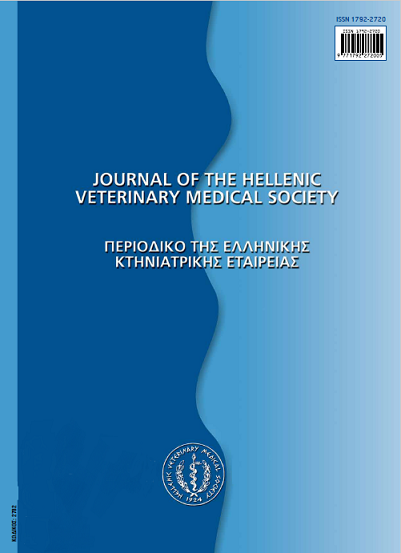Επίδραση της προσθήκης χηλικών ιχνοστοιχείων στα σιτηρέσια και την αναπαραγωγική ικανότητα των χοιρομητέρων

Περίληψη
Τα ιχνοστοιχεία αποτελούν συστατικά πρωτεϊνών και ενζύμων που εμπλέκονται σε μια ποικιλία μεταβολικών διεργασιών, συμμετέχοντας λειτουργικά στην ανάπτυξη, την αναπαραγωγή και την υγεία του ζώου. Τα οργανικά ή χηλικά ιχνοστοιχεία είναι μέταλλα συνδεδεμένα με οργανικούς φορείς, συνήθως αμινοξέα, που σε σύγκριση με τα ανόργανα άλατα των μετάλλων έχουν μεγαλύτερη βιο-διαθεσιμότητα. Στην παρούσα μελέτη διερευνήσαμε την επίδραση της αντικατάστασης, στα σιτηρέσια χοιρομητέρων, μέρους των ανόργανων με χηλικά ιχνοστοιχεία σε τρείς από τους σημαντικότερους δείκτες αναπαραγωγικής απόδοσης, τον αριθμό των γεννηθέντων ζωντανών και απογαλακτισθέντων χοιριδίων και το μεσοδιάστημα απογαλακτισμού μέχρι την πρώτη σπερματέγχυση, σε τρεις Ελληνικές χοιροτροφικές εκμεταλλεύσεις. Πριν την έναρξη της μελέτης τα σιτηρέσια των χοιρομητέρων περιείχαν ανά κιλό τροφής 15mg Cu (από CuSO4), 125mg Zn (από ZnO) και 40mg Mn (από MnO). Μετά την έξοδο από τους θαλάμους τοκετού στα σιτηρέσια των χοιρομητέρων το 93,3%, 36,0% και 62,5% του προστιθέμενου Cu, Zn και Mn, αντίστοιχα, να προέρχεται από εμπορικά διαθέσιμες πηγές χηλικών ιχνοστοιχείων. Καταγράφηκαν τα αναπαραγωγικά δεδομένα που αφορούσαν το συνολικό αριθμό τοκετών, τον αριθμό των γεννηθέντων ζωντανών και των απογαλακτισθέντων χοιριδίων και το μεσοδιάστημα απογαλακτισμού μέχρι την πρώτη σπερματέγχυση σε κάθε μία από 446 χοιρομητέρες, τόσο κατά τον τελευταίο τοκετό με διατροφή που περιείχε ιχνοστοιχεία ανόργανης προέλευσης όσο και για τους επόμενους έναν ή δύο (αντίστοιχα στο 35,0% και 65,0% του συνόλου των χοιρομητέρων) τοκετούς μετά την προσθήκη των χηλικών ιχνοστοιχείων. Για τη σύγκριση του αριθμού των γεννηθέντων ζωντανών και απογαλακτισθέντων χοιριδίων, πριν και μετά την προσθήκη των χηλικών ιχνοστοιχείων, χρησιμοποιήσαμε δύο μικτά γραμμικά μοντέλα παλινδρόμησης, ενώ η διερεύνηση του αντίστοιχου συσχετισμού για το μεσοδιάστημα απογαλακτισμού μέχρι την πρώτη σπερματέγχυση έγινε με τη χρήση ενός αρνητικού διωνυμικού μοντέλου μηδενικού-πληθωρισμού. Βρήκαμε αύξηση (P=0.015) του μέσου όρου των γεννηθέντων ζωντανών χοιριδίων, μετά την προσθήκη των χηλικών ιχνοστοιχείων κατά μισό περίπου χοιρίδιο ανά τοκετό, ενώ αντίθετα δεν υπήρξε καμία επίδραση στον αριθμό των απογαλακτισθέντων χοιριδίων (P=0.15) καθώς και στο μεσοδιάστημα απογαλακτισμού μέχρι την πρώτη σπερματέγχυση (P=0.65). Η μερική αντικατάσταση των ανόργανης προέλευσης με χηλικά ιχνοστοιχεία αυξάνει των αριθμό των γεννηθέντων ζωντανών χοιριδίων, πιθανότατα μέσω της βελτίωσης της βιωσιμότητας των εμβρύων. Ωστόσο, είναι πιθανή και η έμμεση επίδραση των χηλικών ιχνοστοιχείων λόγω της βελτίωσης της υγείας των χηλών και της κινητικής ικανότητας των χοιρομητέρων καθώς και της επακόλουθης βελτίωσης της διατροφικής και σωματικής τους κατάστασης.
Λεπτομέρειες άρθρου
- Πώς να δημιουργήσετε Αναφορές
-
SKAMPARDONIS (Β. ΣΚΑΜΠΑΡΔΩΝΗΣ) V., LISGARA (Μ. ΛΙΣΓΑΡΑ) M., PAPATSIROS (Β. ΠΑΠΑΤΣΙΡΟΣ) V., & LEONTIDES (Λ. ΛΕΟΝΤΙΔΗΣ) L. (2018). Επίδραση της προσθήκης χηλικών ιχνοστοιχείων στα σιτηρέσια και την αναπαραγωγική ικανότητα των χοιρομητέρων. Περιοδικό της Ελληνικής Κτηνιατρικής Εταιρείας, 67(2), 123–128. https://doi.org/10.12681/jhvms.15631
- Τεύχος
- Τόμ. 67 Αρ. 2 (2016)
- Ενότητα
- Research Articles

Αυτή η εργασία είναι αδειοδοτημένη υπό το CC Αναφορά Δημιουργού – Μη Εμπορική Χρήση 4.0.
Οι συγγραφείς των άρθρων που δημοσιεύονται στο περιοδικό διατηρούν τα δικαιώματα πνευματικής ιδιοκτησίας επί των άρθρων τους, δίνοντας στο περιοδικό το δικαίωμα της πρώτης δημοσίευσης.
Άρθρα που δημοσιεύονται στο περιοδικό διατίθενται με άδεια Creative Commons 4.0 Non Commercial και σύμφωνα με την άδεια μπορούν να χρησιμοποιούνται ελεύθερα, με αναφορά στο/στη συγγραφέα και στην πρώτη δημοσίευση για μη κερδοσκοπικούς σκοπούς.
Οι συγγραφείς μπορούν να καταθέσουν το άρθρο σε ιδρυματικό ή άλλο αποθετήριο ή/και να το δημοσιεύσουν σε άλλη έκδοση, με υποχρεωτική την αναφορά πρώτης δημοσίευσης στο J Hellenic Vet Med Soc
Οι συγγραφείς ενθαρρύνονται να καταθέσουν σε αποθετήριο ή να δημοσιεύσουν την εργασία τους στο διαδίκτυο πριν ή κατά τη διαδικασία υποβολής και αξιολόγησής της.




